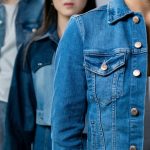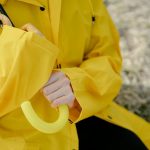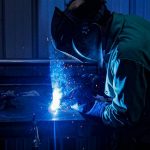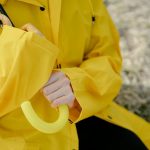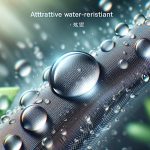You might not realize that the key to a fabric’s windproof qualities lies in its weave and material selection. A tight weave combined with high-density materials can block wind effectively, but there’s more to contemplate. Different technologies and coatings enhance protection while ensuring breathability. Curious about how these elements come together to create the ideal windproof fabric? Let’s explore the characteristics that make these materials essential for your outdoor gear.
Table of Contents
Key Takeaways
- A tight weave using high-density materials like nylon or polyester creates a barrier against strong winds.
- Reinforced seams enhance the integrity of the fabric in high-stress areas, preventing wind penetration.
- Specialized coatings improve durability and block wind while allowing moisture to escape.
- Breathable membranes permit air circulation and moisture vapor escape, maintaining comfort during activities.
- Water resistance complements windproof characteristics, preventing fabric saturation in unpredictable weather conditions.
Tight Weave and Material Selection
When it comes to windproof fabric, the tight weave and material selection play a crucial role in its effectiveness. You’ll find that fabrics with closely woven fibers create a barrier against strong winds, minimizing airflow and keeping you warm.
Look for options made from high-density materials like nylon or polyester, which not only resist wind but also offer durability and flexibility. The right combination of weave and material guarantees the fabric remains lightweight while providing protection.
When selecting windproof clothing, pay attention to how tightly the fibers are woven and the quality of the material. This’ll help you choose garments that effectively shield you from the elements while maintaining comfort during your outdoor adventures.
Specialized Coatings for Enhanced Protection
While tight weaves and material selection are essential, specialized coatings can greatly enhance the windproof capabilities of fabrics. These coatings offer an extra layer of protection against the elements, ensuring you stay warm and comfortable.
Here are some key benefits you can expect from these specialized coatings:
- Durability: Coatings improve the fabric’s lifespan, resisting wear and tear.
- Breathability: Many coatings allow moisture to escape while blocking wind, keeping you dry.
- Lightweight: These coatings add minimal weight, ensuring comfort in movement.
- Versatility: They can be applied to various materials, enhancing a range of outdoor gear.
Laminate Technologies and Waterproofing
When it comes to staying dry and comfortable, laminate technologies like GORE-TEX Infinium play a vital role.
You’ll appreciate how these materials not only provide waterproofing but also enhance windproofing capabilities.
Let’s explore the benefits and connections between these two essential features.
GORE-TEX Infinium Overview
GORE-TEX Infinium stands out in the world of windproof fabrics, thanks to its innovative laminate technologies and waterproofing features.
This fabric combines advanced materials to create a barrier against wind while allowing breathability, ensuring you stay comfortable in various conditions.
Here are some key highlights of GORE-TEX Infinium:
- Windproof Protection: Effectively blocks out chilling winds.
- Breathable Design: Allows moisture to escape, keeping you dry.
- Durable Water Repellency: Resists water without compromising breathability.
- Versatile Applications: Suitable for outdoor activities and everyday wear.
With GORE-TEX Infinium, you can enjoy the perfect blend of comfort and protection, making it an excellent choice for your windproof fabric needs.
Benefits of Laminate Technologies
Laminate technologies play an essential role in enhancing the performance of windproof fabrics like GORE-TEX Infinium. These innovations offer numerous benefits that improve your outdoor experience.
| Benefit | Description |
|---|---|
| Lightweight | Reduces bulk while maintaining warmth |
| Breathability | Allows moisture to escape, keeping you dry |
| Durability | Enhances fabric lifespan against wear |
| Versatility | Suitable for various outdoor activities |
| Comfort | Soft feel against your skin |
Waterproofing and Windproofing Connections
While you may think of waterproofing and windproofing as separate features, they often work hand in hand, especially in the domain of laminate technologies.
These two qualities enhance each other, creating a fabric that effectively protects you from the elements. When selecting windproof materials, look for those that also offer waterproofing benefits.
- Laminate layers: These provide a barrier against both wind and water.
- Breathability: Essential for comfort, allowing moisture to escape while blocking wind.
- Durability: Enhanced resistance to wear and tear, increasing the lifespan of your gear.
- Seam sealing: Prevents water from seeping through seams, guaranteeing complete protection.
Integrating these features guarantees you stay dry and warm, no matter the weather.
Breathability and Moisture Management
When you’re outdoors, staying dry and comfortable is essential.
That’s where moisture-wicking properties and breathable membranes come into play. They work together to manage sweat and keep you feeling fresh, even in windy conditions.
Moisture-Wicking Properties
Understanding moisture-wicking properties is essential for selecting the right windproof fabric, as these features play a crucial role in keeping you comfortable during various activities.
A fabric that effectively wicks moisture away from your skin helps regulate your body temperature and reduces the risk of feeling cold or clammy.
Look for fabrics that offer:
- Quick-drying capabilities
- High breathability to allow air circulation
- Lightweight construction for ease of movement
- Odor-resistant qualities to stay fresh
Breathable Membranes
Moisture management goes hand in hand with breathability, particularly in windproof fabrics. When you wear a windproof layer, it’s essential that sweat can escape, keeping you dry and comfortable. Breathable membranes let moisture vapor pass while blocking wind, guaranteeing you don’t overheat during activities.
Here’s a quick comparison of common breathable membrane types:
| Membrane Type | Features |
|---|---|
| Gore-Tex | Waterproof, highly breathable |
| eVent | Excellent moisture management |
| Pertex | Lightweight, packable |
| Neoshell | Stretchy, good for movement |
Choosing the right breathable membrane can enhance your comfort in windy conditions. It guarantees that you stay warm without feeling clammy, making your outdoor experience much more enjoyable.
Durability and Construction Quality
Durability and construction quality are essential factors that determine the performance of windproof fabric.
When you’re choosing a windproof material, pay attention to these key aspects:
- Tightly woven fibers: These prevent wind from penetrating while maintaining breathability.
- Reinforced seams: Strong seams enhance the fabric’s integrity and longevity, especially in high-stress areas.
- Quality coatings: Durable water repellents can add to the overall effectiveness against wind and moisture.
- Material resilience: Fabrics that resist wear and tear will provide long-lasting protection against harsh elements.
Lightweight Designs and Mobility
While you want protection from the wind, it’s equally important that the fabric allows for ease of movement. Lightweight designs play an essential role in achieving this balance.
Fabrics that are both windproof and lightweight let you move freely, whether you’re hiking, biking, or simply managing your daily routine. You’ll appreciate features like stretchability and breathability, which enhance mobility without compromising on wind resistance.
When a fabric feels heavy or restrictive, it can hinder your performance and enjoyment. Look for windproof options that prioritize comfort and flexibility. This way, you’ll stay agile and focused, even in blustery conditions.
A well-designed, lightweight fabric means you can tackle any activity with confidence, knowing you’re protected without feeling weighed down.
Performance in Various Weather Conditions
When you’re out in unpredictable weather, the right windproof fabric can make all the difference in your comfort and performance. You need a fabric that can handle various conditions, from sudden gusts to light rain.
The best windproof materials provide not just protection but also breathability, so you don’t overheat.
- Blocks chilly winds effectively
- Resists water to keep you dry
- Maintains breathability for comfort
- Offers flexibility for movement
Choosing windproof fabric tailored for diverse weather guarantees you stay focused on your activities.
Whether you’re hiking, biking, or just enjoying a stroll, having the right gear can greatly enhance your experience.
Technical Innovations in Fabric Technology
Advancements in fabric technology have revolutionized how we experience outdoor activities in unpredictable weather. With innovations like breathable membranes, water-resistant coatings, and lightweight materials, you can now enjoy comfort without sacrificing protection. These fabrics are engineered to block wind while allowing moisture to escape, keeping you warm and dry.
Here’s a quick overview of some key technical innovations:
| Innovation | Benefits | Examples |
|---|---|---|
| Breathable Membranes | Prevents overheating | Gore-Tex, eVent |
| Water-Resistant Coatings | Repels moisture | DWR finishes |
| Lightweight Fabrics | Reduces bulk and weight | Nylon, Polyester |
| Stretch Technology | Enhances mobility | Spandex blends |
These changes make outdoor gear more functional and enjoyable, ensuring you’re ready for anything nature throws your way.
Frequently Asked Questions
How Do Windproof Fabrics Compare in Cost to Regular Fabrics?
When you compare windproof fabrics to regular ones, you’ll find windproof options often cost more due to advanced materials and technology. However, the investment can be worth it for enhanced comfort and protection against harsh weather.
Can Windproof Fabrics Be Repaired if Damaged?
Imagine your favorite jacket tearing in the wind. Thankfully, you can often repair windproof fabrics, whether through sewing or using specialized patches. Just check the manufacturer’s guidelines to guarantee your fix keeps the wind out!
Are There Any Eco-Friendly Windproof Fabric Options Available?
Yes, you can find eco-friendly windproof fabric options like recycled polyester or organic cotton blends. These materials not only keep you protected from the wind but also minimize environmental impact, making them a great choice for conscious consumers.
How Long Do Windproof Fabrics Typically Last?
Windproof fabrics are like shields in a storm, designed to endure. Typically, they last several years with proper care, but factors like usage and exposure can wear them down faster than you’d expect.
Can Windproof Fabrics Be Used for Layering in Cold Weather?
Yes, you can definitely use windproof fabrics for layering in cold weather. They block chilly winds effectively, keeping you warmer. Just make sure to pair them with breathable materials to manage moisture and maintain comfort.
- Does Chiffon Fabric Stink - July 15, 2025
- Does Chiffon Fabric Affect the Economy - July 15, 2025
- Does Cotton Fabric Have a Nap - July 15, 2025


